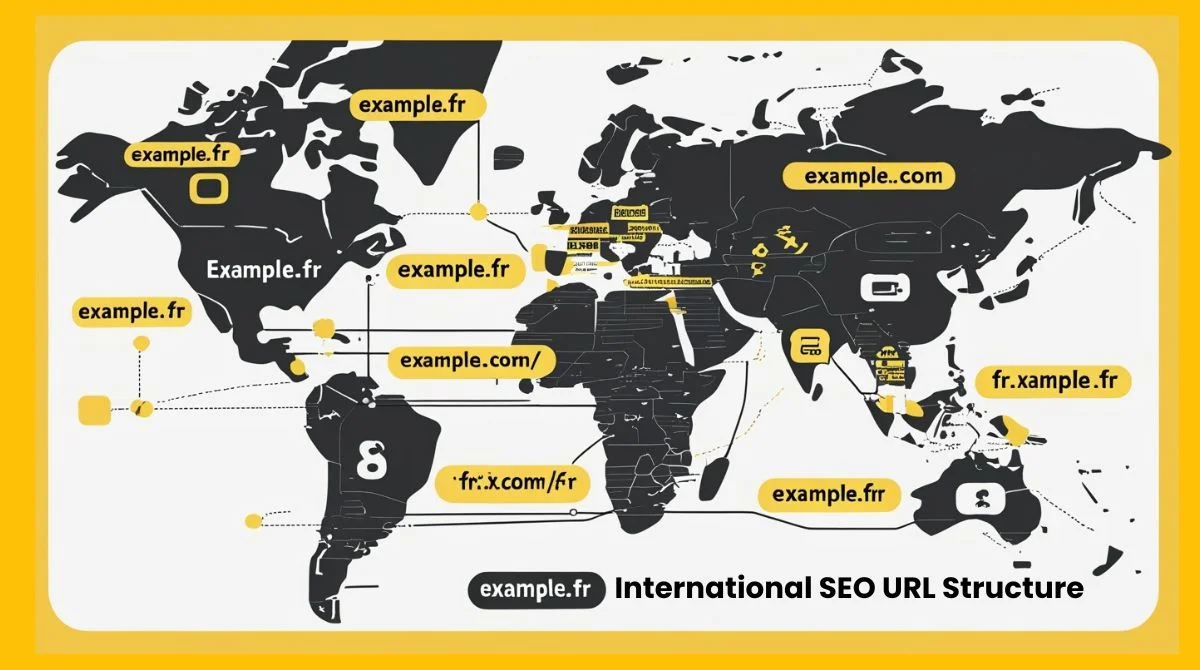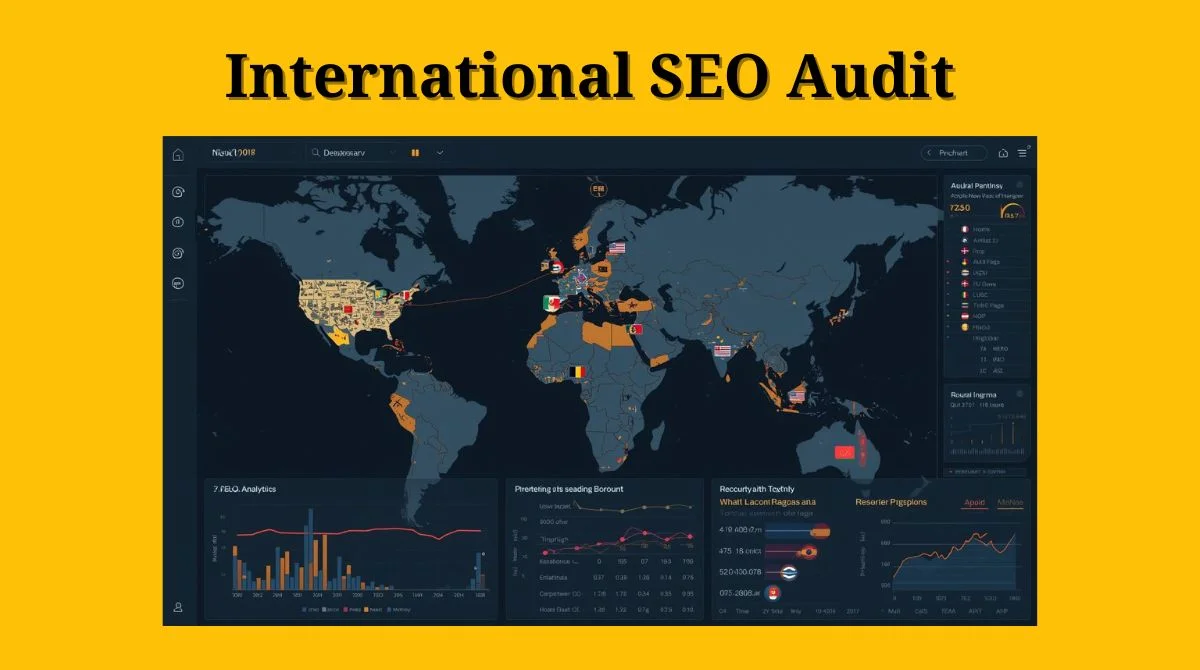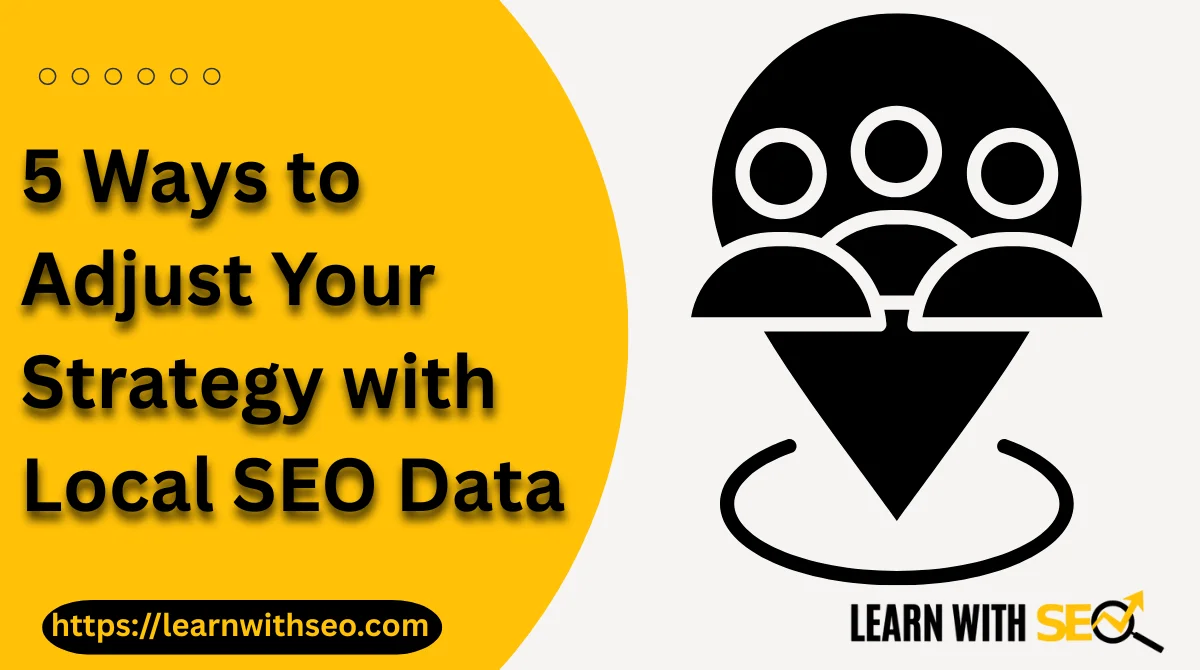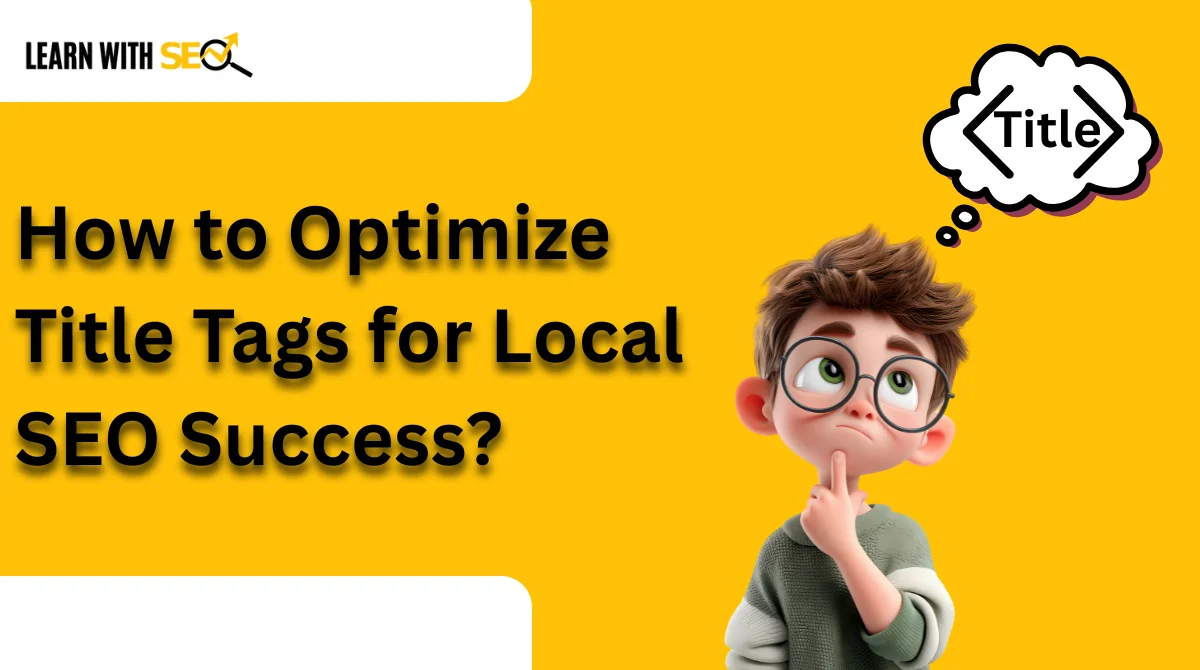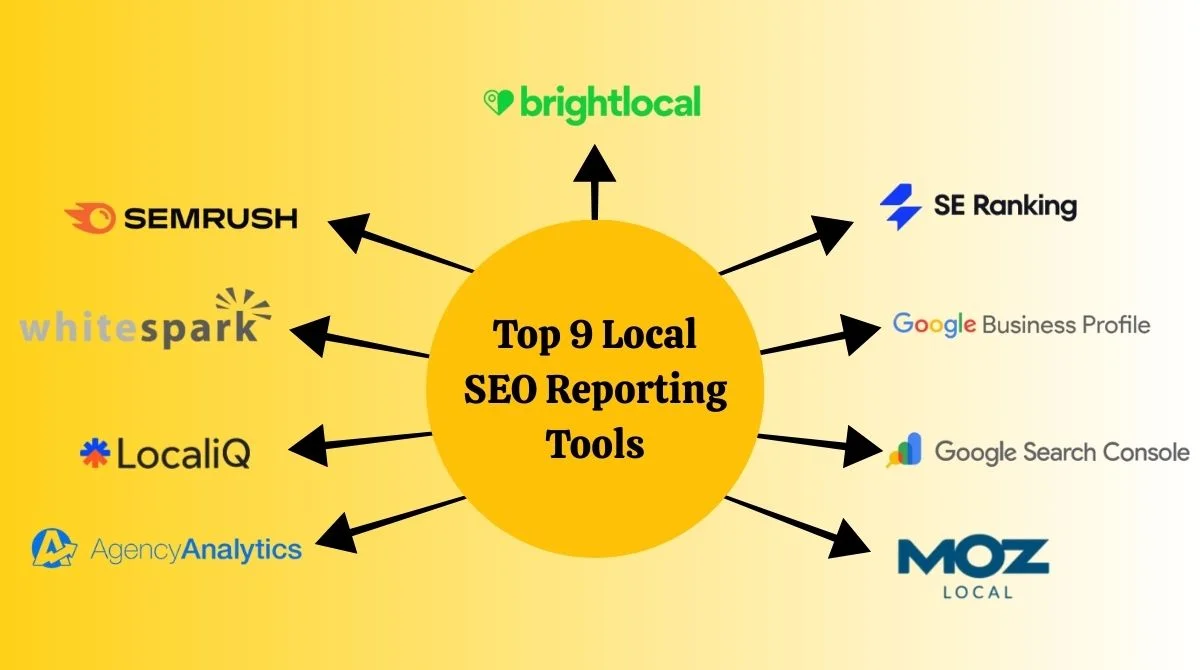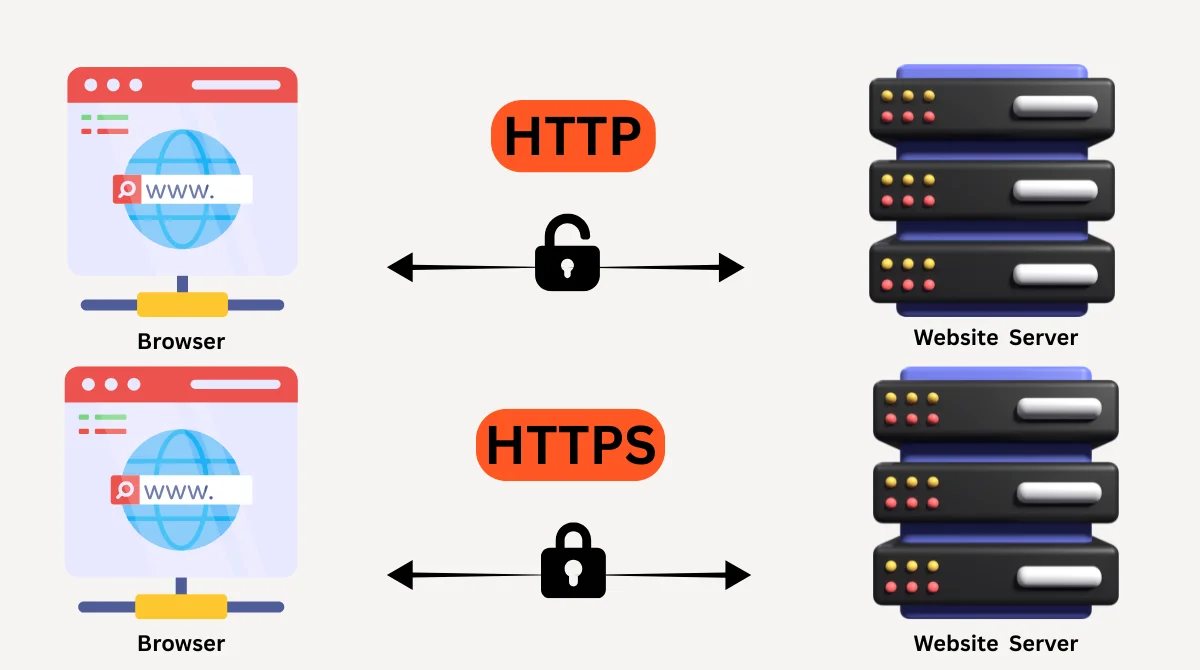Content marketing goes beyond simply sharing blogs or posting on social media. It is the art and science of creating valuable content that attracts the right people, keeps them engaged, and drives them to take action. In today’s digital age, where users spend hours daily searching, watching, reading, and comparing, having a strong content marketing strategy is essential for every business. Without a clear strategy, your efforts may end up scattered and fail to deliver results.
Why Content Marketing Matters?
Content marketing is not just about selling products. It is about building trust, authority, and relationships with your audience. People no longer want to be pushed into buying; they want to be educated, inspired, and guided. A well-designed content strategy helps your brand achieve the following:
- Increase brand awareness.
- Build authority in your industry.
- Improve organic search traffic.
- Educate your target audience.
- Generate high-quality leads.
- Drive sales with trust-based marketing.
When done right, content marketing becomes the engine that fuels long-term growth.
Proven Steps to Build a Content Marketing Strategy
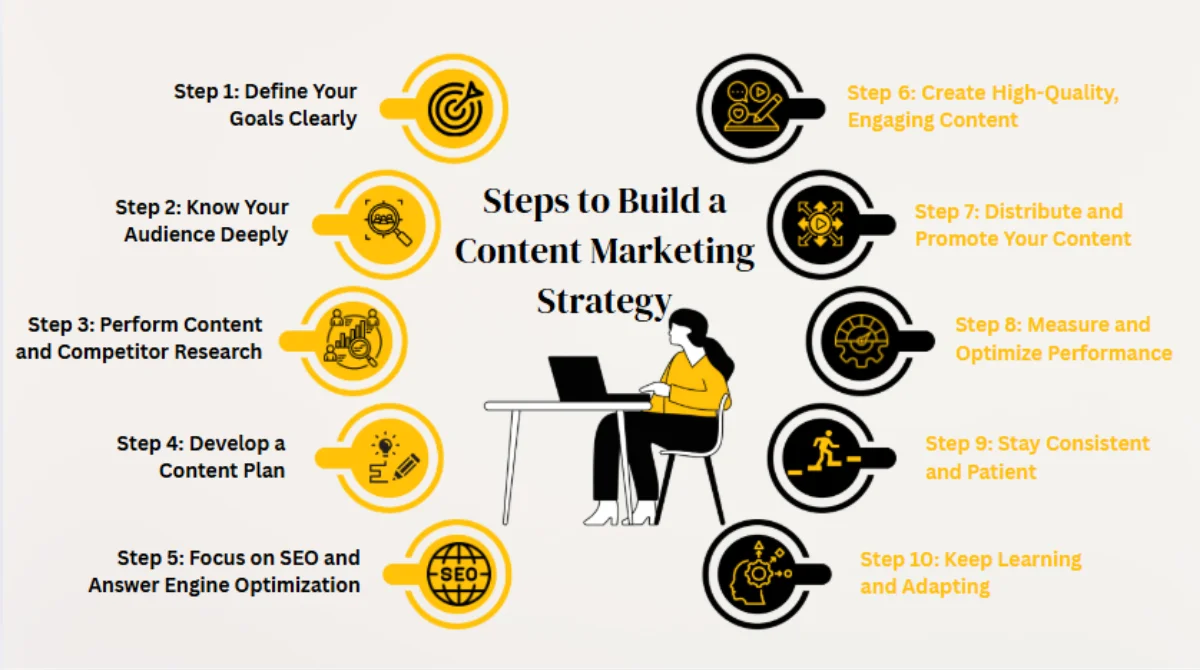
A content marketing strategy is like a roadmap; it defines how you will attract the right audience, educate them, and eventually convert them into loyal customers. Below are 10 essential steps every business should follow to build a successful content marketing strategy.
Step 1: Define Your Goals Clearly
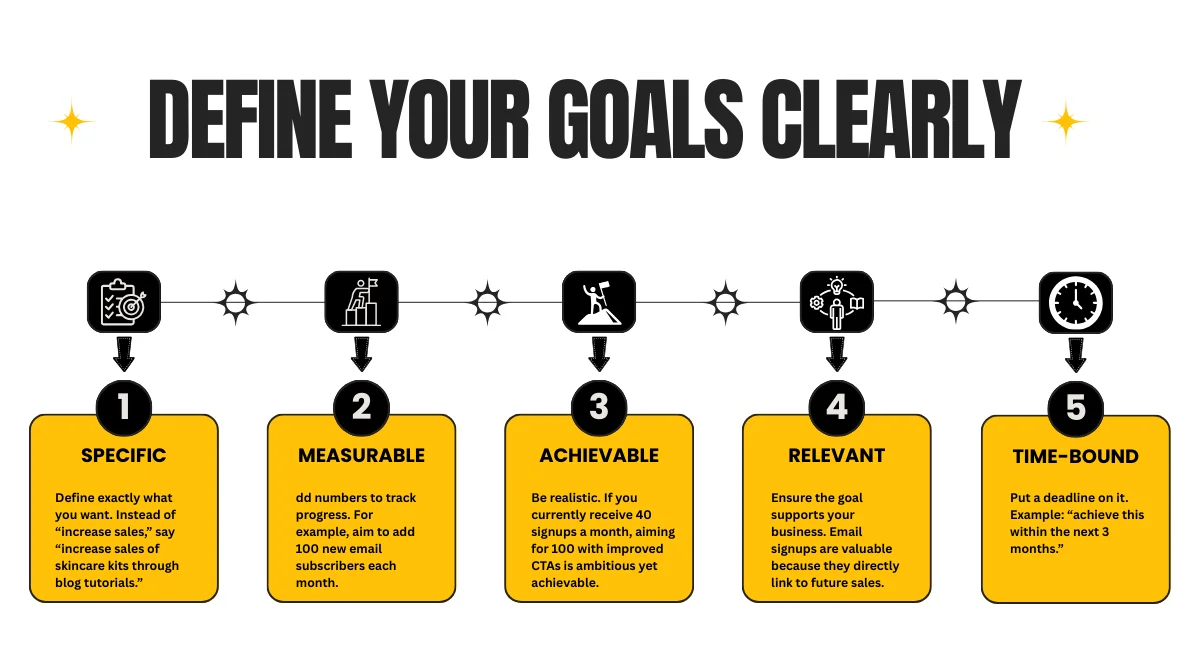
Every great content marketing strategy starts with a simple question: What do you want to achieve? If you don’t know the answer, your content will feel directionless. Goals are like the steering wheel of your strategy; they keep you on track and prevent you from wasting energy.
A common mistake businesses make is setting goals that are too broad. Saying “I want more traffic” or “I want brand awareness” may sound good, but it’s too vague. Instead, goals should be crystal clear and tied to actual business outcomes. The most effective approach is to establish SMART goals:
- Specific: Define exactly what you want. Instead of “increase sales,” say “increase sales of skincare kits through blog tutorials.”
- Measurable: Add numbers to track progress. For example, aim to add 100 new email subscribers each month.
- Achievable: Be realistic. If you currently receive 40 signups a month, aiming for 100 with improved CTAs is ambitious yet achievable.
- Relevant: Ensure the goal supports your business. Email signups are valuable because they directly link to future sales.
- Time-bound: Put a deadline on it. Example: “achieve this within the next 3 months.”
Example in action: Imagine you own an online store selling organic skincare. Instead of saying “We want more customers,” a SMART goal could be: “Within three months, we will grow sales by 20% by publishing weekly skincare routine blogs that include product links and tutorials.”
Step 2: Know Your Audience Deeply
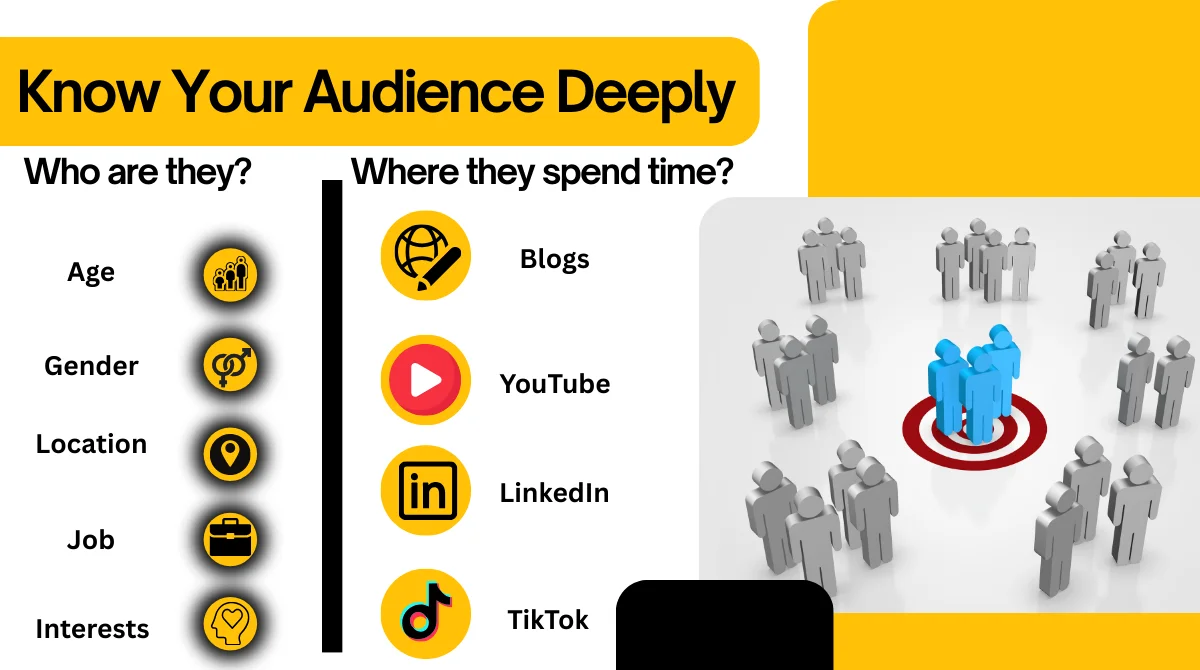
Content marketing is only effective when it speaks directly to the right audience. To do this, you need to understand your ideal customer.
Start by asking:
- Who are they? (age, gender, location, job, interests)
- What are their problems or challenges?
- What type of content do they consume online?
- Where do they spend their time: blogs, YouTube, LinkedIn, or TikTok?
Building detailed buyer personas can help. For example, if you are selling marketing software, one persona could be a “Marketing Manager, 30–45 years old, working in mid-sized companies, struggling with lead tracking.” Knowing this, you can create content like case studies, how-to guides, and templates that solve their specific problems.
Step 3: Perform Content and Competitor Research
Before creating content, you need to study what is already working in your industry. Think of it as doing homework before an exam. If you know what competitors are doing well, you can create even better content.
Start with competitor analysis. Look at the top players in your niche and ask:
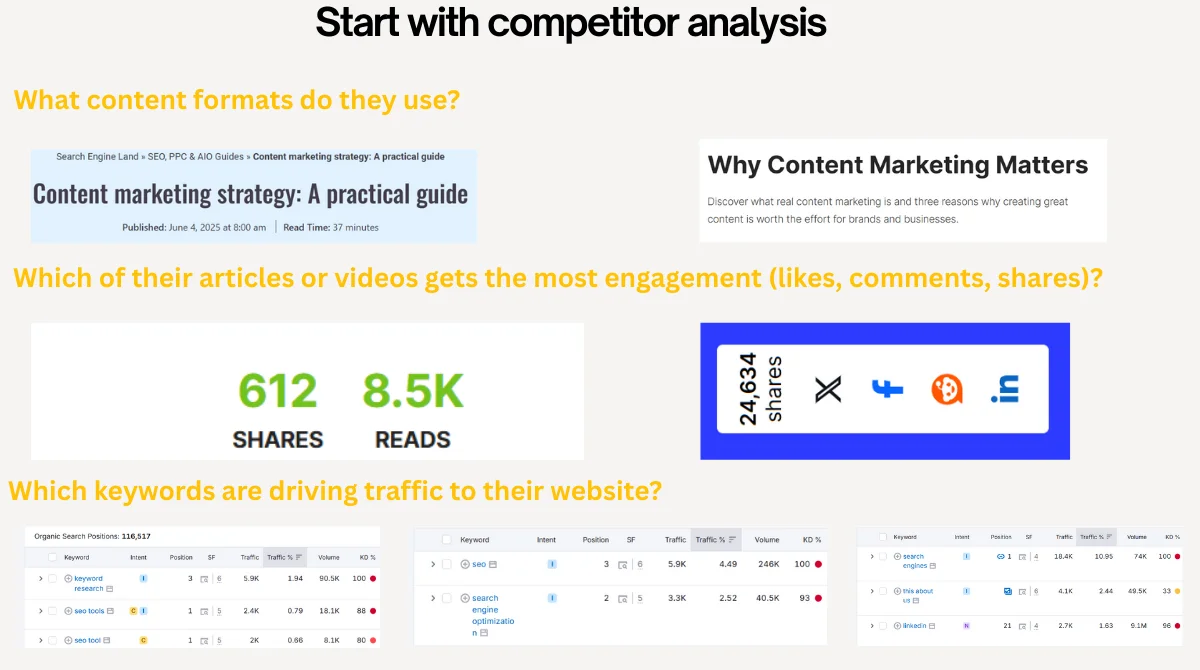
- What content formats do they use? (blogs, videos, podcasts, infographics)
- Which of their articles or videos gets the most engagement (likes, comments, shares)?
- Which keywords are driving traffic to their website?
This is where keyword research tools like SEMrush, Ahrefs, Moz, or Google Keyword Planner come in. When you enter a competitor’s domain, you’ll be able to view:
- The top-performing keywords that bring them traffic.
- The pages they rank for and the estimated traffic each one receives.
- The content gaps where they are not ranking, but you could create content to fill the void.
For example, if your competitor is ranking for “best running shoes for beginners” and “marathon training tips,” but you notice they don’t have content around “affordable running shoes under $100,” then that’s your opportunity. You can target this keyword with a blog post, comparison guide, or even a video.
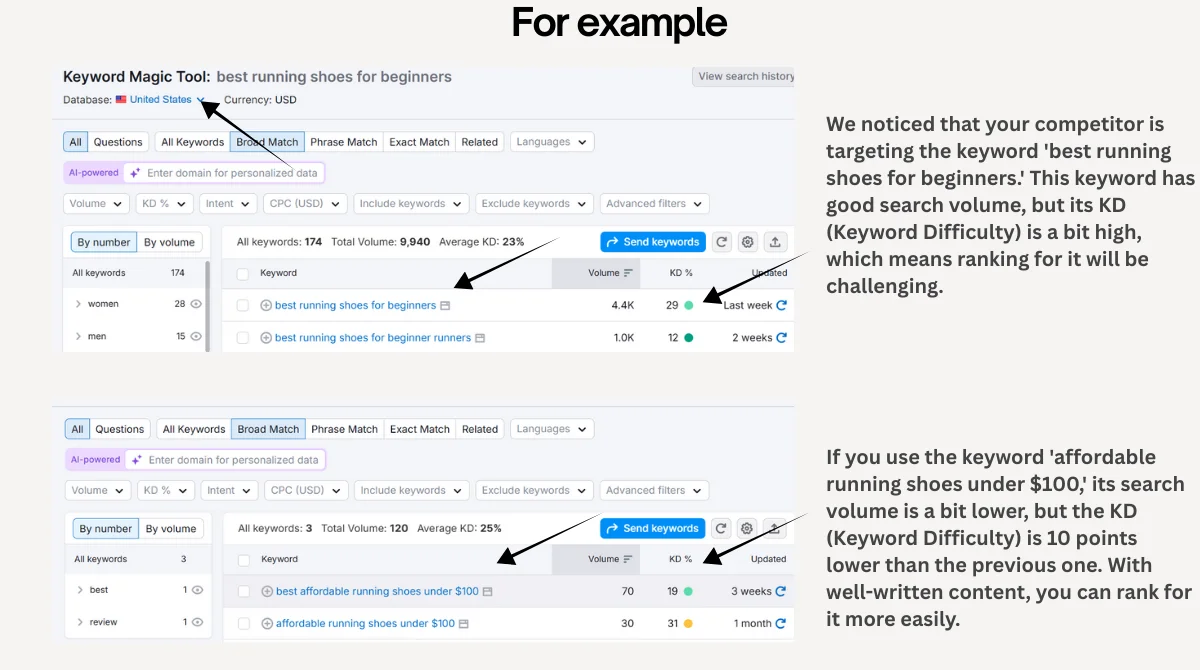
Another smart move is to look at long-tail keywords your competitors may be ignoring. Instead of targeting just “content marketing,” which is very competitive, you could go after “content marketing strategy for small businesses in 2025.” These longer keywords have less competition but often bring more qualified traffic.
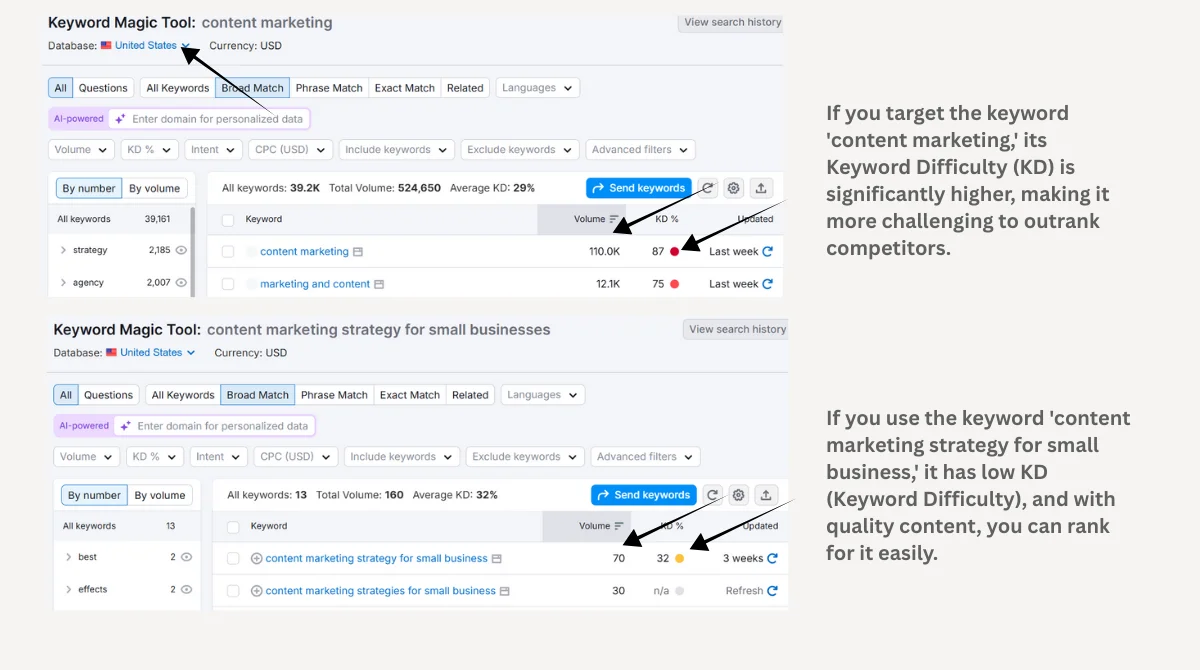
Competitor keyword research is not about copying; it’s about spotting patterns, understanding demand, and finding the gaps that you can fill with better, more valuable, and more detailed content.
Step 4: Develop a Content Plan
A content plan serves as a strategic guide that defines the type of content to produce, the publishing schedule, and its connection to overall business objectives. Instead of publishing random blogs or posts, a content plan ensures consistency, SEO alignment, and audience engagement. It helps marketers track deadlines, assign tasks, and optimize content around keywords that drive organic traffic.
A strong content plan typically includes:
- Dates: Publishing timeline for consistency.
- Topics & Titles: Based on keyword research and audience needs.
- Focus & LSI Keywords: To rank higher on search engines.
- Content Status: Tracking progress (approved, pending, in progress, optimized).
- Distribution: Where and how the content will be shared.
Example: Weekly Content Plan Sheet
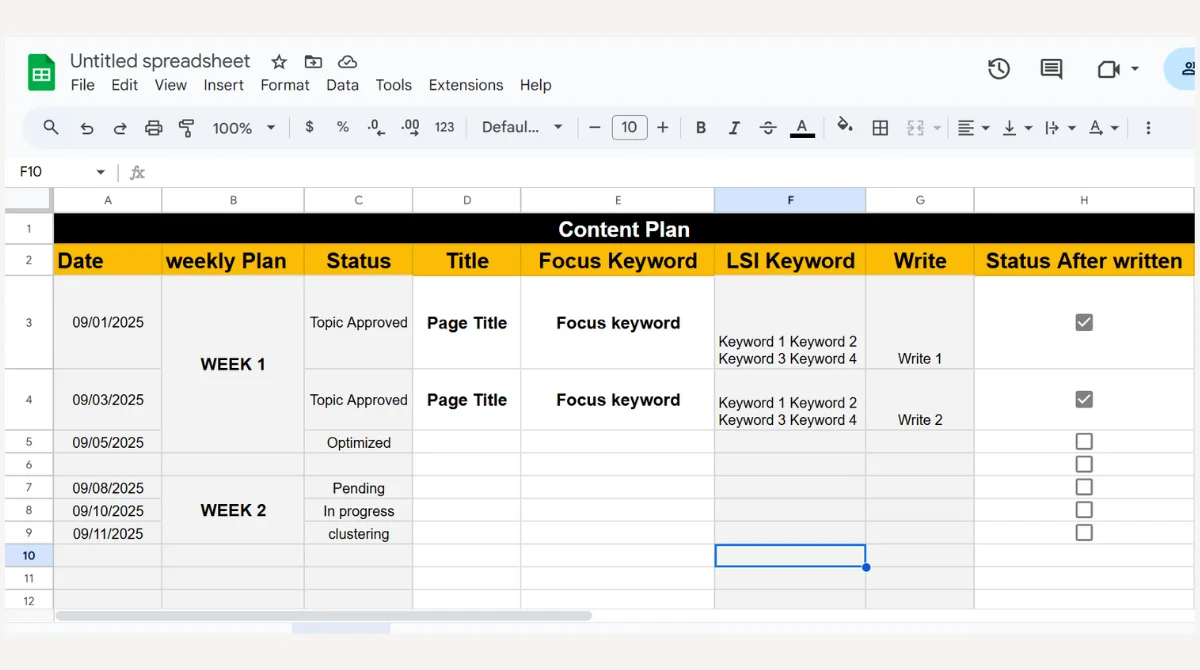
Your sheet is a weekly SEO content plan that organizes tasks clearly:
- Date → Defines the publishing or writing deadlines (e.g., 09/01/2025, 09/03/2025).
- Weekly Plan → Divides work into weeks (Week 1, Week 2) to maintain consistency.
- Status → Tracks approval stages such as Topic Approved, Pending, In Progress, Optimized.
- Title → Placeholder for page titles or blog titles (optimized later with keywords).
- Focus Keyword → The main keyword each article targets for SEO ranking.
- LSI Keywords → Related terms (Keyword 1, Keyword 2, Keyword 3, Keyword 4) to capture search intent.
- Write → Assignments like Write 1, Write 2, to track who is responsible.
- Status After Writing → Use a checkbox system to confirm completion once the writing task is done.
Why this format works for SEO:
- Keeps publishing schedule consistent (important for Google).
- Ensures every piece is optimized with focus + LSI keywords.
- Tracks workflow (from idea → writing → optimization → published).
- Helps avoid duplication and keeps content aligned with the SEO strategy.
This way, your content plan is not just a task list but a search engine-driven strategy designed to boost visibility, traffic, and authority.
Step 5: Focus on SEO and Answer Engine Optimization
Creating great content is only half the journey. If people can’t find it, it won’t serve its purpose. To make sure your content is visible, you need to optimize it for both traditional search engines (SEO) and answer engines like Google’s Featured Snippets, People Also Ask, and even AI-powered search results.
Here’s how you can do it effectively:
Use focus keywords naturally
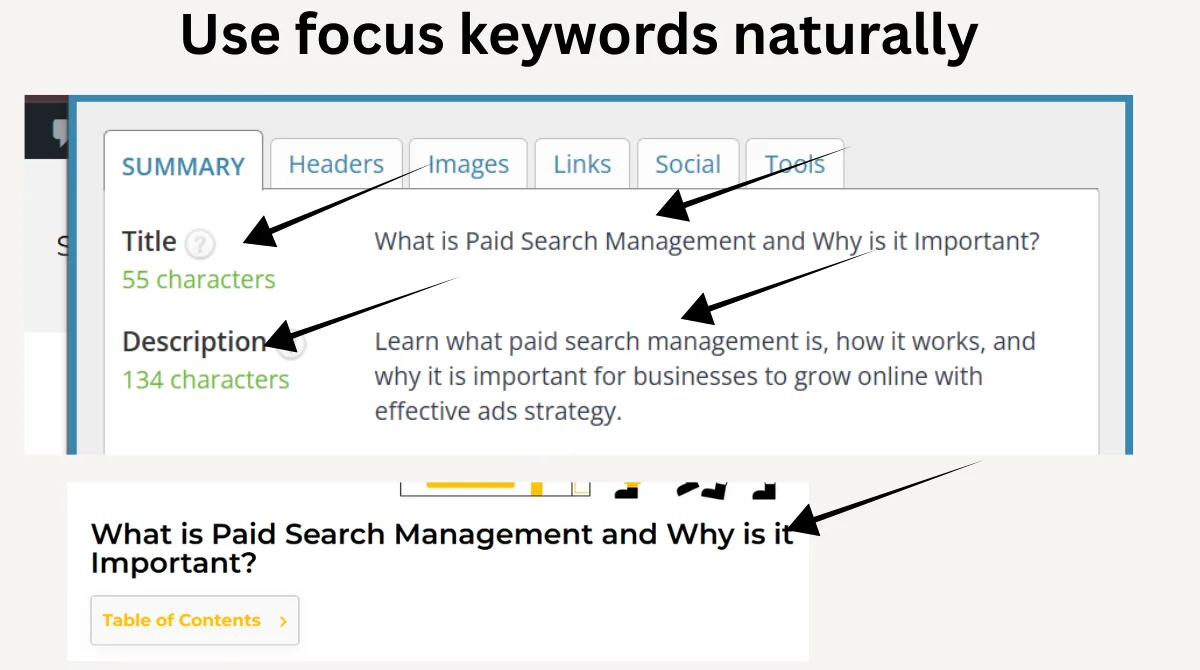
Keywords are like signboards for your content. Place your main keyword in the title, meta description, first 100 words, and headings, but avoid stuffing. For example, if your keyword is “Paid search management,” your title could be “What is Paid Search Management and Why is it Important?”
Add LSI (related) keywords
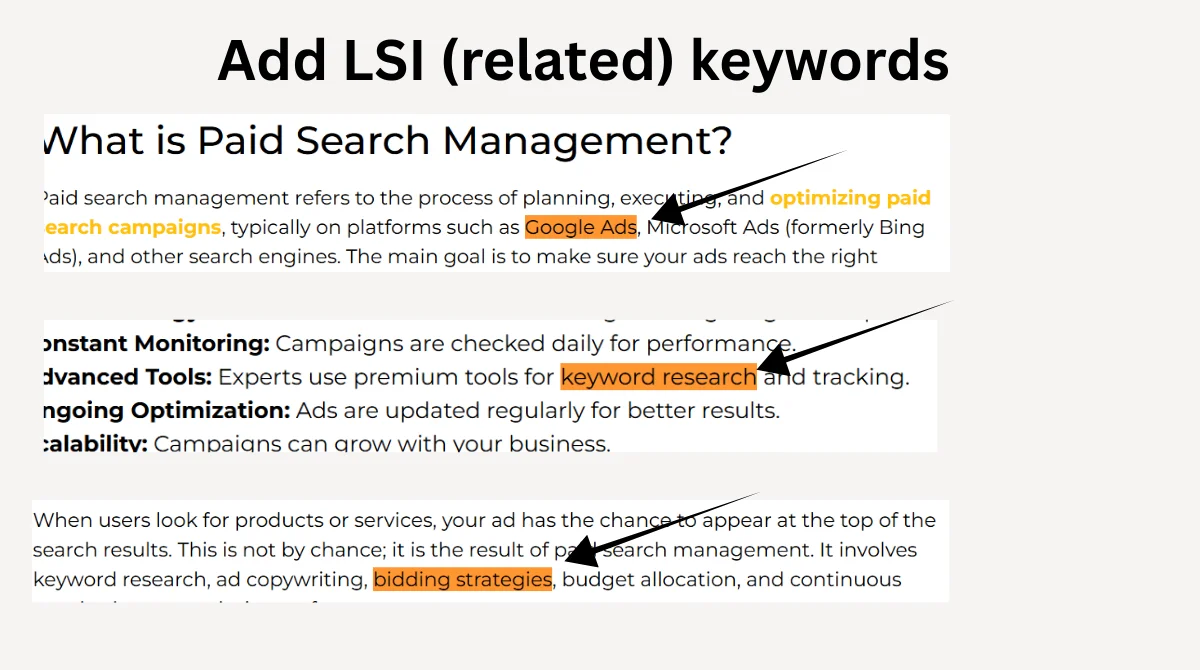
Search engines today don’t just look for one keyword; they look at the context. Use related terms like “Google Ads,” “keyword research,” or “bidding strategies” within your article. This helps cover the full search intent and improves visibility.
Structure content with headings (H2, H3)
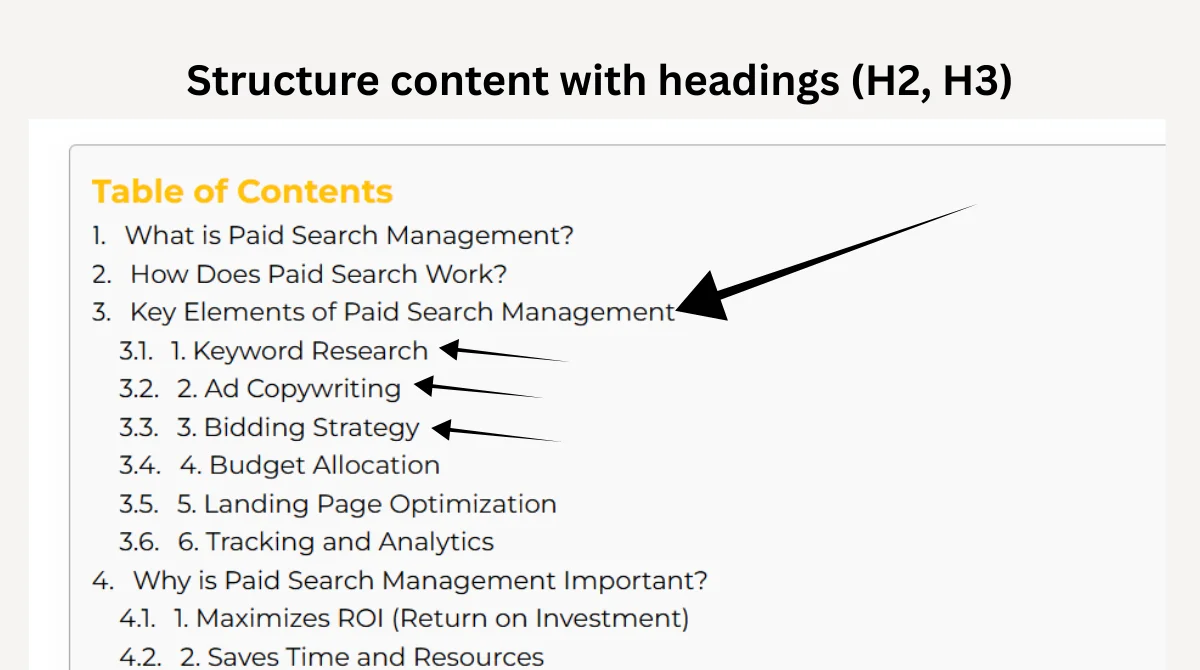
Think of headings as a roadmap. A well-structured blog with H2 and H3 tags makes it easy for readers to scan and helps Google understand the hierarchy of your ideas. For instance, under “Key Elements of Paid Search Management,” you can break it into H3 sections like “Keyword Research” and “Ad Copywriting.”
Provide direct answers to common questions
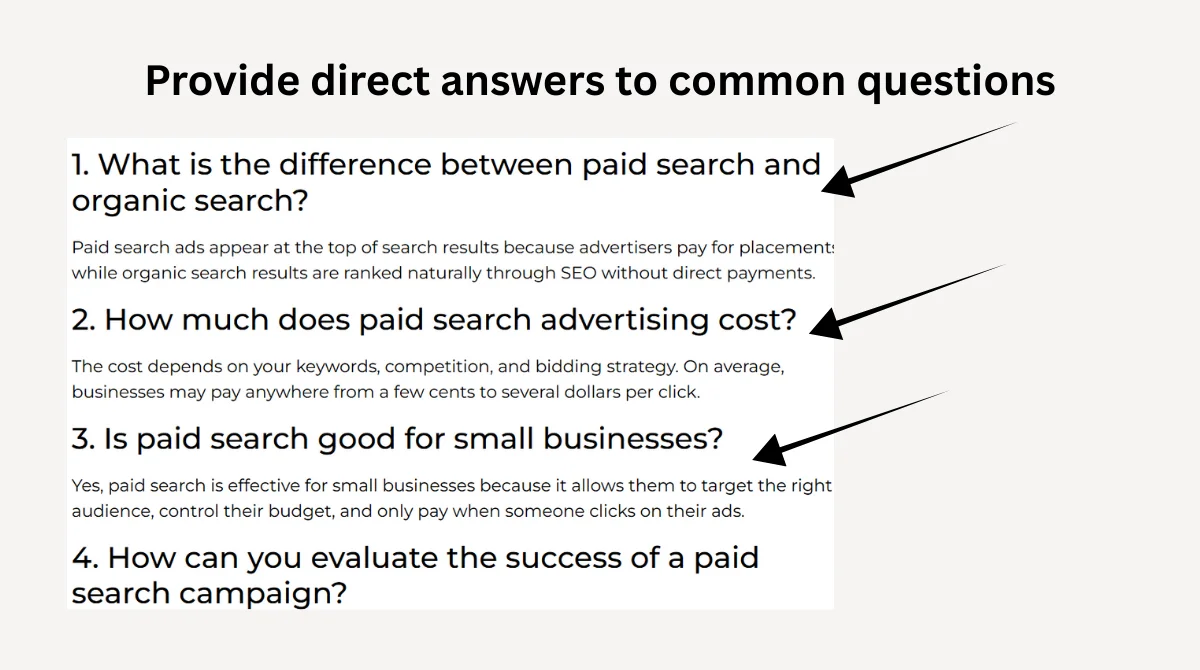
Answer engines love concise answers. For example, if someone asks, “How much does paid search advertising cost?” give a simple one-line definition before going into detail. This improves your likelihood of showing up in Featured Snippets or the ‘People Also Ask’ section.
Use bullet points and short paragraphs
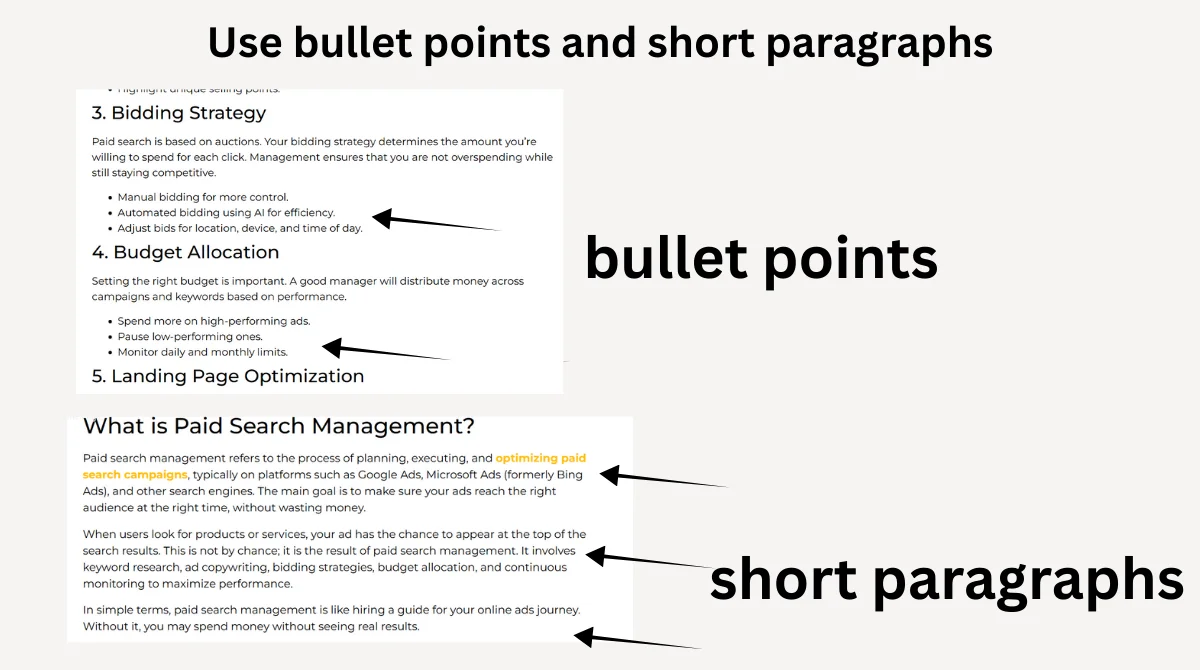
Online readers skim more than they read. Breaking down ideas into short paragraphs and bullet points improves readability, keeps readers engaged, and aligns with answer engine formats.
Add internal links to related content
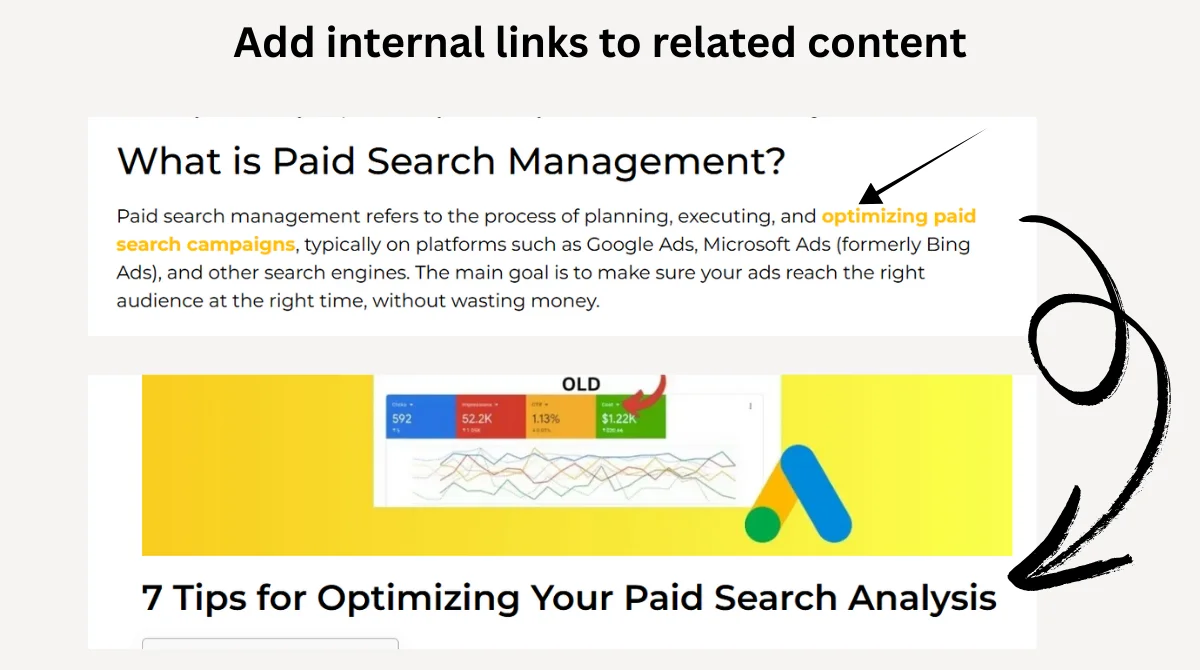
If you’ve written related blogs or guides, link them naturally. For example: “Read our guide on optimizing paid search campaigns.” This not only helps SEO but also keeps users on your website longer.
Include external credible sources
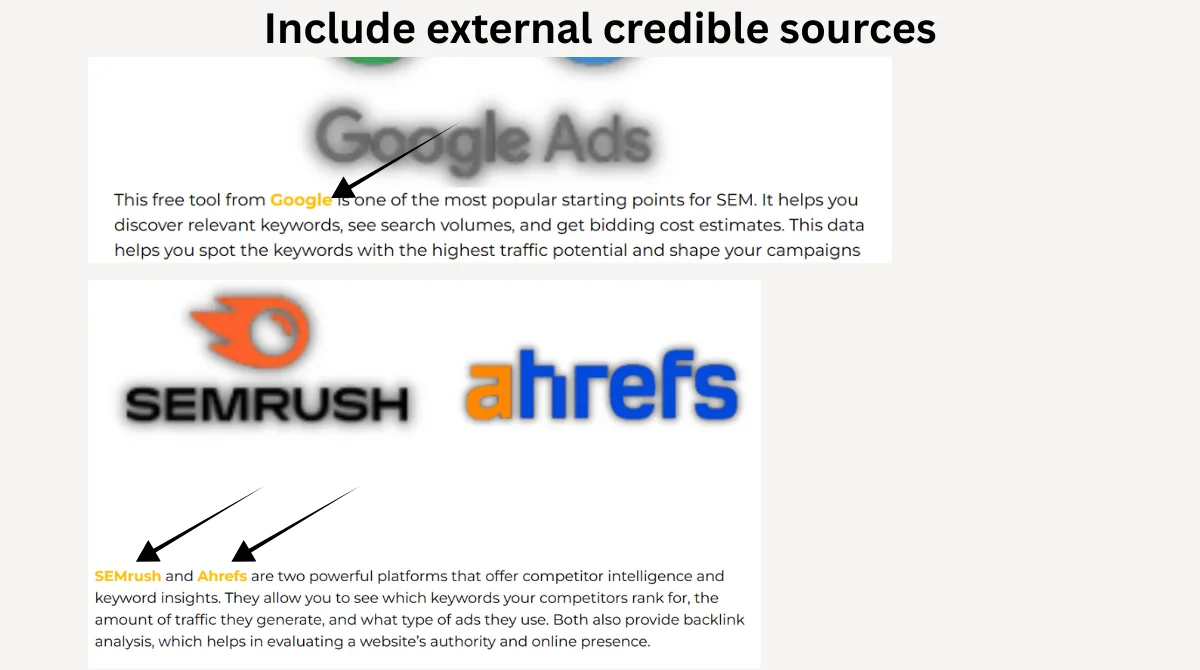
Adding links to reputable sources (such as Google, Semrush, or recognized industry reports) signals to search engines that your content can be trusted. It also builds trust with readers because you’re backing your claims with data and authority.
Step 6: Create High-Quality, Engaging Content
The heart of content marketing lies in the quality of what you produce. High-quality content should be useful, engaging, and tailored to your audience’s needs.
Qualities of strong content include:
- Clear, simple language that is easy to read
- Actionable advice or solutions
- Visual support such as images, charts, or videos
- Storytelling elements to connect emotionally
- A professional tone that matches your brand identity
For example, instead of writing a generic blog on “E-commerce Content Strategy,” you could write a detailed guide titled “What is the Best E-commerce Content Strategy for Growth?” This helps make your content more targeted, useful, and easy to share.
Step 7: Distribute and Promote Your Content
Publishing great content is only half the job; the other half is promoting it effectively. Use multiple channels to make sure your content reaches your audience.
Ways to distribute and promote content include:
- Sharing on social media platforms.
- Sending through email newsletters.
- Collaborating with influencers or partners.
- Transforming existing content into new formats (for example, converting a blog post into a video).
- Running paid ads on Facebook, LinkedIn, or Google.
- Posting on industry forums and Q&A platforms like Quora.
The more visibility your content gets, the better chance it has to drive traffic and leads.
Step 8: Measure and Optimize Performance
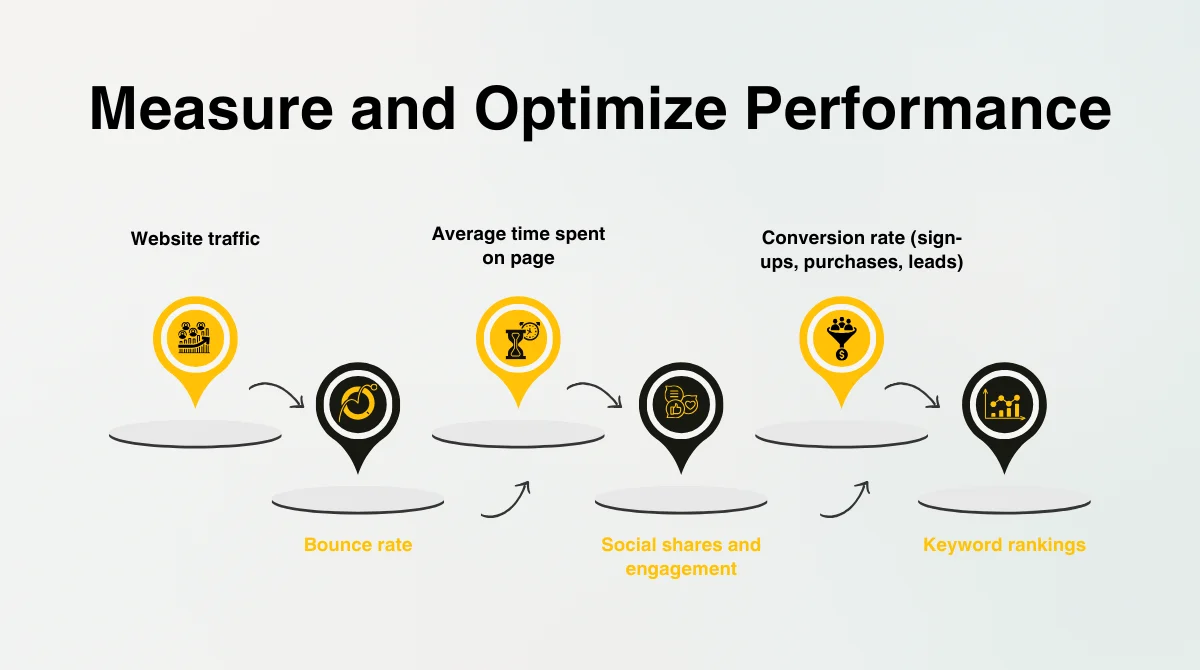
To build a successful content marketing strategy, you must track performance and improve over time. Use analytics tools to measure how your content is performing.
Key metrics to track:
- Website traffic
- Bounce rate
- Average time spent on page
- Social shares and engagement
- Conversion rate (sign-ups, purchases, leads)
- Keyword rankings
Based on these insights, update and optimize old content, refine your strategy, and double down on what’s working.
Step 9: Stay Consistent and Patient
Content marketing is not a one-time activity. It takes time to see results. Consistency is the key. Publishing once in a while will not build authority or trust. Brands that win in content marketing are those that consistently create, update, and promote valuable content over the long term.
Step 10: Keep Learning and Adapting
The digital landscape changes quickly. What works today may not work tomorrow. AI, social media algorithms, and search engine updates are constantly evolving. Stay updated with industry news, test new formats, and keep improving your approach. A successful content marketing strategy is flexible, adaptable, and always customer-focused.
Why E-E-A-T Matters in Content Marketing?
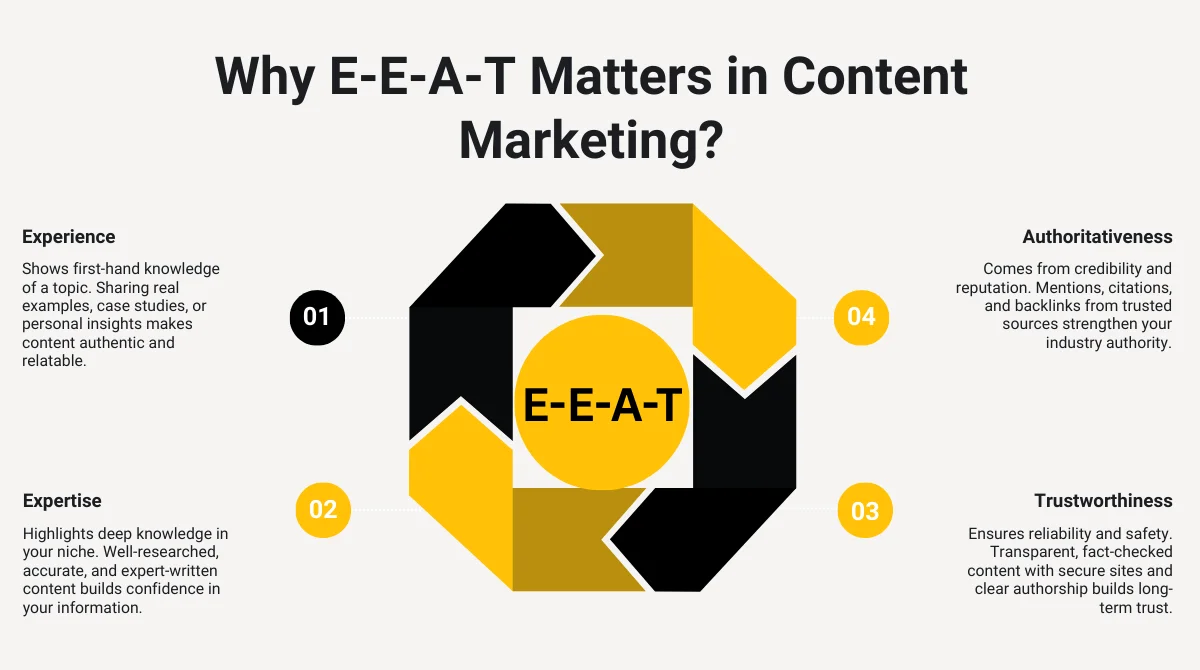
- Experience: Shows first-hand knowledge of a topic. Sharing real examples, case studies, or personal insights makes content authentic and relatable.
- Expertise: Highlights deep knowledge in your niche. Well-researched, accurate, and expert-written content builds confidence in your information.
- Authoritativeness: Comes from credibility and reputation. Mentions, citations, and backlinks from trusted sources strengthen your industry authority.
- Trustworthiness: Ensures reliability and safety. Transparent, fact-checked content with secure sites and clear authorship builds long-term trust.
Final Thoughts
A successful content marketing strategy isn’t about random posts; it’s about knowing your audience, setting clear goals, and creating valuable, SEO-optimized content. By focusing on education, inspiration, and connection, your strategy can boost traffic, build trust, and drive long-term business growth.


